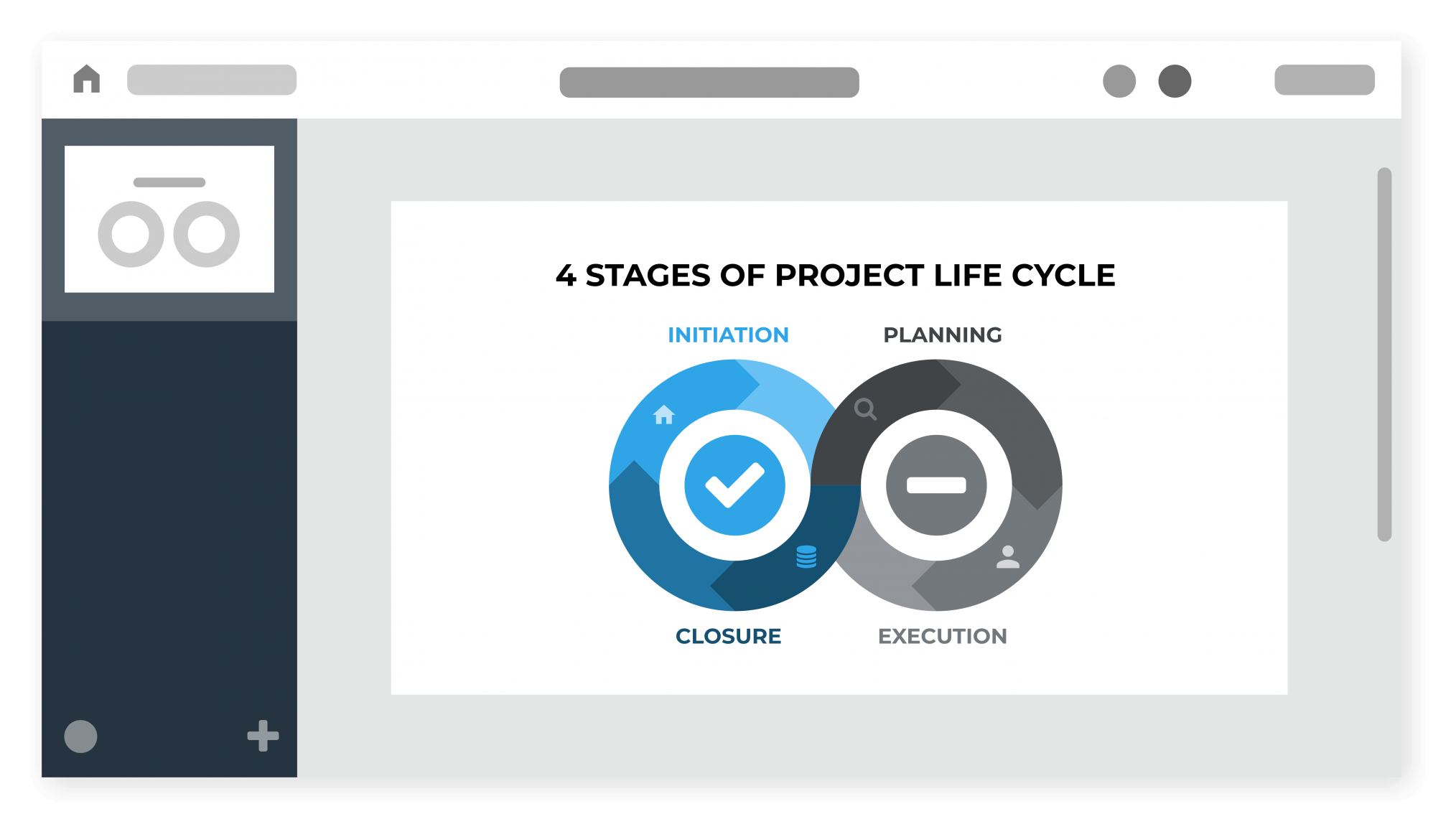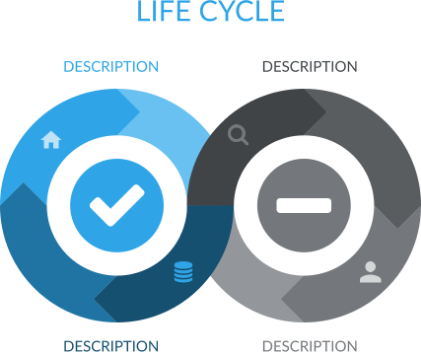Project Life Cycle
Learn how to create a project life cycle diagram that will work as a guide in your next project.

As seen on:




Visualize your project
Even if you’re not a project manager you’re bound to have some work projects that could benefit from a little more structure. Maybe you won’t need to follow all the steps of each of the phases we describe below, but bear in mind that the success or failure of a project often stems from the phases prior to execution (initiation and planning). We’ll cover all of that in the article.
4 distinct phases
Initiation
Planning
Execution
Closing
Initiation phase
You then need to write down some ideas on how to seize the opportunity, meet the requirement or solve the problem.
At this stage we recommend some brainstorming to evaluate the different alternatives so you can create a list of
the recommended solutions.
Next you’ll need to evaluate how those different solutions compare to each other and how they address the project’s goal. To help you decide which alternative is the best one, consider the following factors:
Evaluate feasibility — Is it possible to deliver this solution to the problem?
Define the scope — Do you have a good understanding of the depth and width in which you will solve the problem.
Specify deliverables — What exactly will you provide to solve the problem? Detail the products and/or services that you can provide.
Make a list of stakeholders — Who will be affected by this project and how?
Create a business case — Build a projection of the costs and benefits of the project so you can evaluate if it makes economic sense.
Create a statement — This should be a summary of all the points described above, which will work as an agreement between the project manager and the owner.
Once the project is approved, you can move on to planning your project and forming a team. Your project manager will decide when to conclude this initiation phase and move on to the planning.
Planning phase
Now the goal of this second planning phase is to refine and further develop the solution, breaking it down into smaller parts and tasks. Once the big goal has been divided into smaller ones, teams can be formed and assigned to each micro-goal.
This part is really important as the more specific the goal, the more likely it is to be met.
There are several different steps in this phase:
Create a project outline — You should divide the project into phases and identify the tasks that need to be done in each of them. Set deadlines for each particular phase and task.
Set up a budget — The project manager needs to estimate the costs for completing each task including salaries, software, raw material, licenses, rental, etc. And then define how the project will be financed.
List the required resources — This includes the teams that will take part and also all the tools such as software, hardware or materials that are required
Establish a communication plan — The stakeholders were identified in the initiation phase of the project. Now it’s time to determine what information each stakeholder needs and the best way to deliver it.
Risk Management Analysis — In any project there will be threats than can endanger a smooth execution. But the risks can be significantly minimized if they’re analyzed beforehand. Sometimes risk management will focus on eliminating or reducing the probability of certain problems happening, but in other cases it will simply be about minimizing the impact, as some risks are inevitable.
Quality plan — Now it’s time to define the quality targets and consider the control measures to ensure those targets are met. In some cases, you’ll need to define specific acceptance criteria that will detail what elements must be there for a deliverable to be accepted.
Once your project manager has collected and organized all of this information, it’s best is to start with a kick-off meeting. This will help to initiate the project, answer any questions that team members might have and make sure everyone has what they need to start working.

Execution phase
Execution is the time where your team will make the plan a reality. The project manager will make sure deadlines are met, team members have all they need to execute and everything is moving as planned.
Also they will need to monitor the quality by comparing the work with the acceptance criteria and address any problems that occur. In the ideal scenario any problems are solved and it’s possible to return to the original plan, but in practice a divergence from the original plan is sometimes unavoidable, in which case your project manager will be responsible for informing the team, management, clients and stakeholders.
At the same time there needs to be tight control of the budget to identify any overspend at an early stage. And when some unexpected cost appears, you’ll need to address it quickly and appropriately.
It is crucial that during this phase there is an efficient communication flow, so team members, stakeholders, clients and other managers are always aware of what’s going on.
Depending on the nature and scope of the project, different project management methodologies can be used to provide steps in the execution. Some of the most common methodologies are Scrum, Agile, Waterfall or Kanban – your project manager will decide which is the best option.
The execution phase ends once all deliverables are finished and the client is happy with the result.
Closing phase
But there are still some last steps to make sure the project is properly closed.
In this phase, your project manager will end any contracts with suppliers and release and allocate resources to other projects, check there are no loose ends, communicate the completion with stakeholders, etc.
It is also time to evaluate the project. Some of the elements to analyze are:
Performance — Were project deadlines met, tasks accomplished and budgets respected? Has the initial opportunity been realized / requirement met or problem been solved?
Teams — Did team members meet their goals on time and with the required quality, as set out by the acceptance criteria?
Lessons learnt — What can be improved? Evaluate the lessons learnt during the project by analyzing what went well and what didn’t go so well. This information should be properly considered to improve future projects and ensure the same mistakes aren’t made again.
Budget — Identify if part of the budget remains unused and allocate it accordingly.
Reporting — Make sure the information collected during this phase is provided to any stakeholder that needs it.
With this, the project is officially completed.
Creating a diagram in Xara Cloud for your next project is a perfect way to structure your ideas and plan the different phases accordingly. We have more than 30 diagrams that you can use in your presentations, reports or other business documents.
